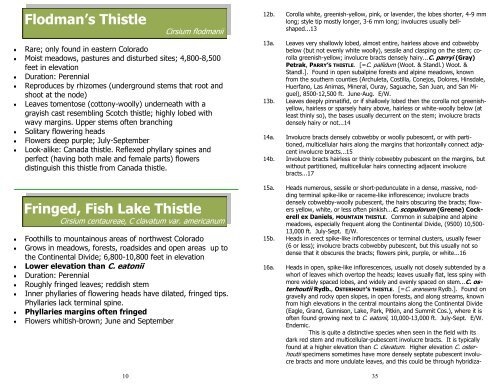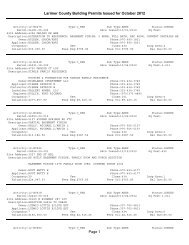Thistles of Colorado - Summit County Government
Thistles of Colorado - Summit County Government
Thistles of Colorado - Summit County Government
You also want an ePaper? Increase the reach of your titles
YUMPU automatically turns print PDFs into web optimized ePapers that Google loves.
Flodman’s Thistle<br />
10<br />
Cirsium flodmanii<br />
Rare; only found in eastern <strong>Colorado</strong><br />
Moist meadows, pastures and disturbed sites; 4,800-8,500<br />
feet in elevation<br />
Duration: Perennial<br />
Reproduces by rhizomes (underground stems that root and<br />
shoot at the node)<br />
Leaves tomentose (cottony-woolly) underneath with a<br />
grayish cast resembling Scotch thistle; highly lobed with<br />
wavy margins. Upper stems <strong>of</strong>ten branching<br />
Solitary flowering heads<br />
Flowers deep purple; July-September<br />
Look-alike: Canada thistle. Reflexed phyllary spines and<br />
perfect (having both male and female parts) flowers<br />
distinguish this thistle from Canada thistle.<br />
Fringed, Fish Lake Thistle<br />
Cirsium centaureae, C clavatum var. americanum<br />
Foothills to mountainous areas <strong>of</strong> northwest <strong>Colorado</strong><br />
Grows in meadows, forests, roadsides and open areas up to<br />
the Continental Divide; 6,800-10,800 feet in elevation<br />
Lower elevation than C. eatonii<br />
Duration: Perennial<br />
Roughly fringed leaves; reddish stem<br />
Inner phyllaries <strong>of</strong> flowering heads have dilated, fringed tips.<br />
Phyllaries lack terminal spine.<br />
Phyllaries margins <strong>of</strong>ten fringed<br />
Flowers whitish-brown; June and September<br />
12b. Corolla white, greenish-yellow, pink, or lavender, the lobes shorter, 4-9 mm<br />
long; style tip mostly longer, 3-6 mm long; involucres usually bellshaped...13<br />
13a. Leaves very shallowly lobed, almost entire, hairless above and cobwebby<br />
below (but not evenly white woolly), sessile and clasping on the stem; corolla<br />
greenish-yellow; involucre bracts densely hairy...C. parryi (Gray)<br />
Petrak, PARRY’S THISTLE. [=C. pallidum (Woot. & Standl.) Woot. &<br />
Standl.]. Found in open subalpine forests and alpine meadows, known<br />
from the southern counties (Archuleta, Costilla, Conejos, Dolores, Hinsdale,<br />
Huerfano, Las Animas, Mineral, Ouray, Saguache, San Juan, and San Miguel),<br />
8500-12,500 ft. June-Aug. E/W.<br />
13b. Leaves deeply pinnatifid, or if shallowly lobed then the corolla not greenishyellow,<br />
hairless or sparsely hairy above, hairless or white-woolly below (at<br />
least thinly so), the bases usually decurrent on the stem; involucre bracts<br />
densely hairy or not...14<br />
14a. Involucre bracts densely cobwebby or woolly pubescent, or with partitioned,<br />
multicellular hairs along the margins that horizontally connect adjacent<br />
involucre bracts...15<br />
14b. Involucre bracts hairless or thinly cobwebby pubescent on the margins, but<br />
without partitioned, multicellular hairs connecting adjacent involucre<br />
bracts...17<br />
15a. Heads numerous, sessile or short-pedunculate in a dense, massive, nodding<br />
terminal spike-like or raceme-like inflorescence; involucre bracts<br />
densely cobwebby-woolly pubescent, the hairs obscuring the bracts; flowers<br />
yellow, white, or less <strong>of</strong>ten pinkish...C. scopulorum (Greene) Cockerell<br />
ex Daniels, MOUNTAIN THISTLE. Common in subalpine and alpine<br />
meadows, especially frequent along the Continental Divide, (9500) 10,500-<br />
13,000 ft. July-Sept. E/W.<br />
15b. Heads in erect spike-like inflorescences or terminal clusters, usually fewer<br />
(6 or less); involucre bracts cobwebby pubescent, but this usually not so<br />
dense that it obscures the bracts; flowers pink, purple, or white...16<br />
16a. Heads in open, spike-like inflorescences, usually not closely subtended by a<br />
whorl <strong>of</strong> leaves which overtop the heads; leaves usually flat, less spiny with<br />
more widely spaced lobes, and widely and evenly spaced on stem...C. osterhoutii<br />
Rydb., OSTERHOUT’S THISTLE. [=C. araneans Rydb.]. Found on<br />
gravelly and rocky open slopes, in open forests, and along streams, known<br />
from high elevations in the central mountains along the Continental Divide<br />
(Eagle, Grand, Gunnison, Lake, Park, Pitkin, and <strong>Summit</strong> Cos.), where it is<br />
<strong>of</strong>ten found growing next to C. eatonii, 10,000-13,000 ft. July-Sept. E/W.<br />
Endemic.<br />
This is quite a distinctive species when seen in the field with its<br />
dark red stem and multicellular-pubescent involucre bracts. It is typically<br />
found at a higher elevation than C. clavatum. Higher elevation C. osterhoutii<br />
specimens sometimes have more densely septate pubescent involucre<br />
bracts and more undulate leaves, and this could be through hybridiza-<br />
35





